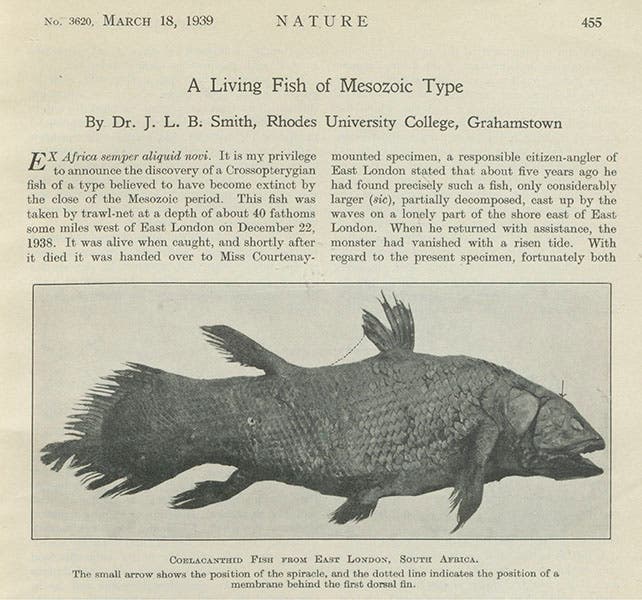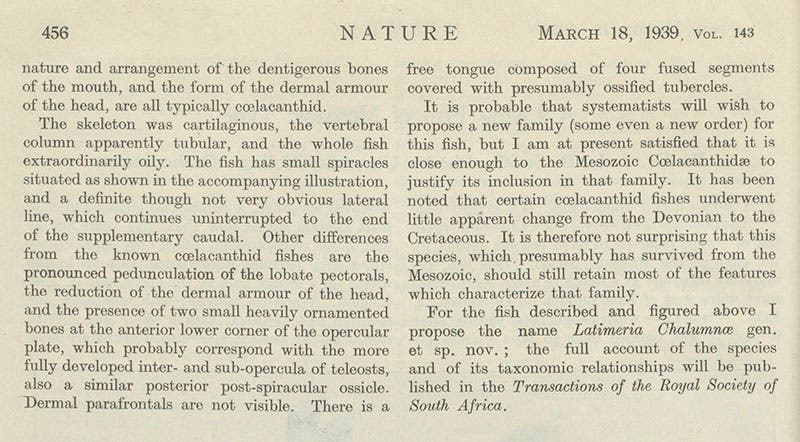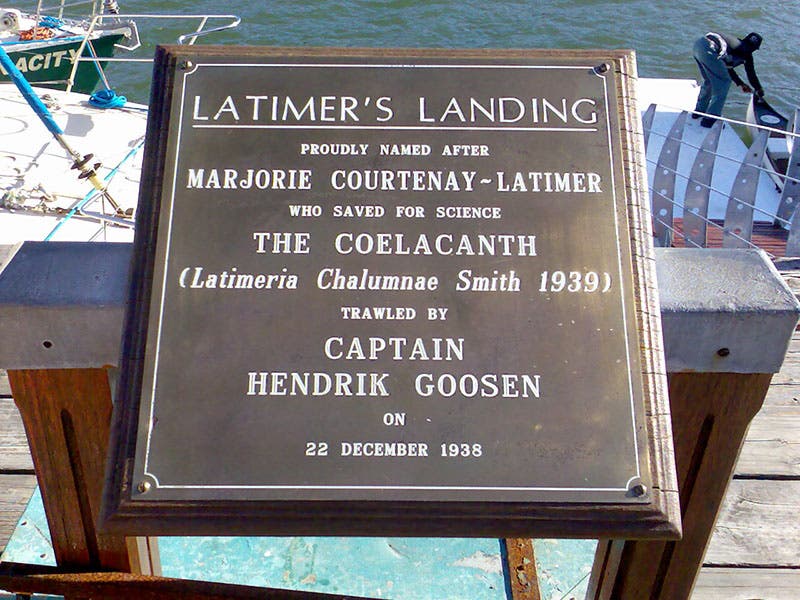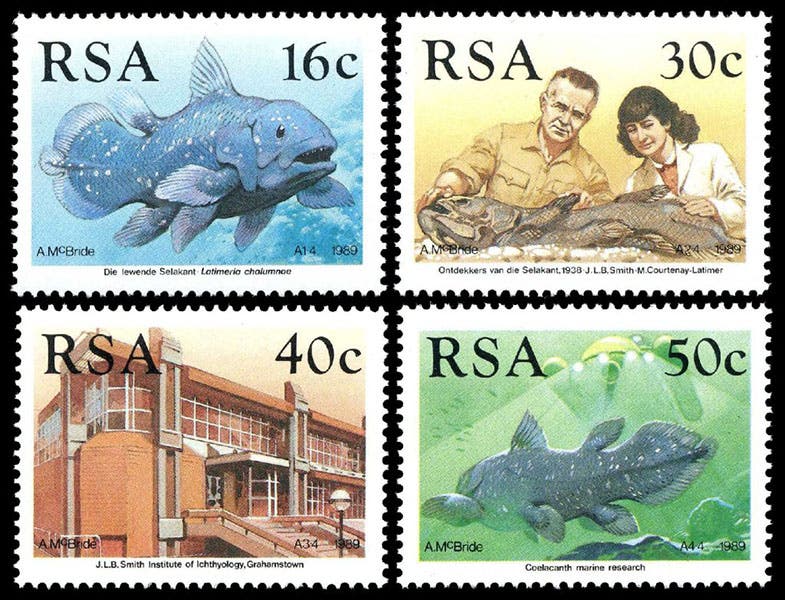Scientist of the Day - Marjorie Courtenay-Latimer
Marjorie Courtenay-Latimer, a South African naturalist and museum curator, was born Feb. 24, 1907. In 1931, she backed into a job as curator of the East London Museum – East London being a port city in South Africa – for which she had no training or experience, aside from her knowledge of South African plants and wildlife. In hindsight, the hiring was inspired. Eager to expand the Museum’s collections, she placed a standing request with several local fishermen that she be informed if anything unusual (and unmarketable) showed up in their nets.
On Dec. 22, 1938, Courtenay-Latimer received a phone call from one of the trawler operators, saying he had quite a stack of garbage fish on his deck and asking if she wanted to check them out. So she took a taxi (yes, a taxi) to the dock and discovered, in the piscine pile of scaly squigglers, a highly unusual blue specimen, about 5 feet long, with four fins as stout as legs, and a stumpy tail. She had no idea what it was, but she was convinced it should be preserved and shown to an expert, so she loaded it into the taxi (yes, into the taxi) and was conveyed back to the Museum.
Courtenay-Latimer immediately telephoned an ichthyologist acquaintance, J.L.B. Smith, in nearby Grahamstown, but she couldn’t reach him. So she wrote him a letter, suggesting that this might be something special, requesting his immediate presence, and even enclosing a drawing (first image). Smith, as it turned out, was away, and when Marjorie did not hear from him after repeated phone calls and letters, she had to have the fish mounted by the taxidermist, and the internal organs disposed of.
When Smith finally got back to Grahamstown on Jan. 3 and read the letters and saw the sketch, he was nearly frantic, because he suspected that this was a living survivor of a lobe-finned fish, thought to have been extinct for 65 million years – a coelacanth. When he finally saw the remains a month later, even though the fleshy parts were gone, he knew his suspicion was correct.
Smith officially announced the discovery on Mar. 18, 1939, in a letter to Nature, accompanied by a photograph of the specimen (third image). At the end of his letter, Smith gave the specimen its scientific name, calling it Latimeria chalumnae, the genus named after the discoverer, and the species after the Chalumna River where it was hauled in (fourth image). A fuller description, with more photographs, appeared in the Transactions of the Royal Society of Africa in 1940 (fifth image).
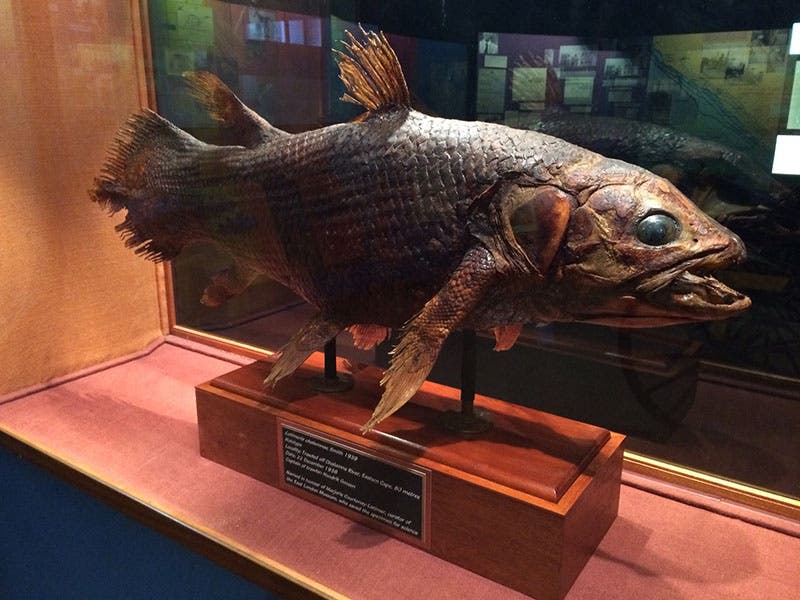
The original coelacanth captured in 1938 and preserved by Marjorie Courtenay-Latimer, now in the East London Museum, RSA, modern photograph (Jessica Glass on wordpress.com)
For 14 years, this was the only coelacanth specimen known, but in 1952, another was brought up from the deeps in the Comoro Islands, and Smith was there to see it. Many have been found since, and even more have been observed alive by divers in their underwater habitat.
Courtenay-Latimer never did anything else nearly as notable during the rest of her career at the East London Museum, but she didn’t need to – her 12 weeks of fame were quite enough. Her name is known to every ichthyologist, and she is quite a hero still in South Africa. You can see the original coelacanth in the East London Museum (sixth image), and should you go down to the docks, you can find a plaque commemorating that momentous day of discovery of Dec. 22, 1938 (seventh image). The Republic of South Africa (RSA) even issued a block of four postage stamps in 1989, commemorating the coelacanth and its discoverers (eighth image).
The letters exchanged by Courtenay-Latimer and J.L.B. Smith during the weeks after the discovery are preserved at the South African Institute for Aquatic Biodiversity (SAIAB) in Grahamstown, formerly the JLB Smith Institute of Ichthyology; several of them can be read here. They brim with the excitement of a once-in-a-lifetime discovery, even 80 years later. Dr. William B. Ashworth, Jr., Consultant for the History of Science, Linda Hall Library and Associate Professor emeritus, Department of History, University of Missouri-Kansas City. Comments or corrections are welcome; please direct to ashworthw@umkc.edu.



